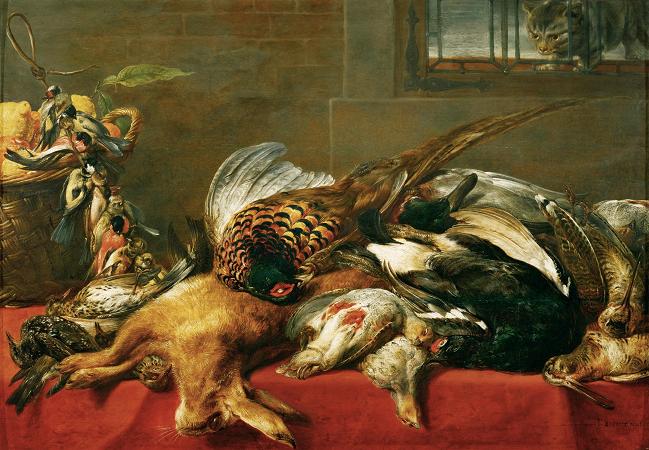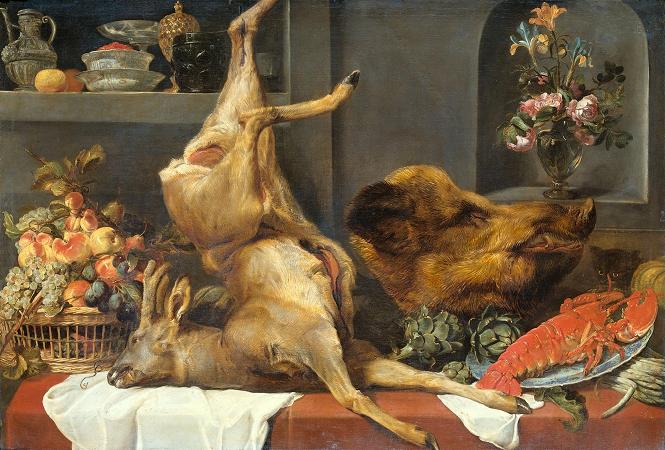Still Life with Dead Game. Game or quarry is any animal hunted for sport or for food, and the meat of those animals. The type and range of animals hunted for food varies in different parts of the world. Game or quarry is any animal hunted for its meat or for sport. The term game arises in medieval hunting terminology by the late 13th century and is particular to English, the word derived from the generic Old English gamen joy, amusement, sport, merriment. Quarry in the generic meaning is early modern, in the more specific sense bird targeted in falconry late 14th and 15th centuries as quirre entrails of deer placed on the hide and given to the hunting-dogs as a reward, from Old French cuiriee spoil, quarry, but influenced by corée viscera, entrails. AcWild game meat is generally considered to be superior in nutrient density, and usually has lower fat content, than meat procured through contemporary farming methods, while the cost in time and money to procure wild game is much higher. Small game includes small animals, such as rabbits, pheasants, geese or ducks. Large game includes animals like deer, moose, and bear. Big game is a term sometimes used interchangeably with large game although in other contexts it refers to large, typically African, mammals which are hunted mainly for trophies. The type and range of animals hunted for food varies in different parts of the world. This is influenced by climate, animal diversity, local taste and locally accepted views about what can or cannot be legitimately hunted. Sometimes a distinction is also made between varieties and species of a particular animal, such as wild turkey and domestic turkey. Fish caught for sport are referred to as game fish. The flesh of the animal, when butchered for consumption is often described as having a gamey flavour. This difference in taste can be attributed to the wild diet of the animal, which usually results in a lower fat content compared to domestic farm raised animals. In some countries, game is classified, including legal classification with respect to licences required, as either small game or large game. A single small game licence may cover all small game species and be subject to yearly bag limits. Large game are often subject to individual licensing where a separate licence is required for each individual animal taken. In some parts of Africa, wild animals hunted for their meat are called bushmeat; see that article for more detailed information on how this operates within the economy and the law. Animals hunted for bushmeat include, but are not limited to: Various species of antelope, including duikers. Various species of primates like mandrills or gorillas. Rodents like porcupines or cane rats. Some of these animals are endangered or otherwise protected, and thus it is illegal to hunt them. In Africa, animals hunted for their pelts or ivory are sometimes referred to as the big game. Also see the legal definition of game in Swaziland. South Africa is a famous destination for game hunting, with its large biodiversity and therefore rather impressive variety of game species. Many creatures have returned to former areas from which they were once taken from as a result of being killed for big-game hunting. Species of creatures commonly hunted include: Springbok. Impala. Steenbok. Oribi. Bushbuck. Nyala. Greater Kudu. Common Eland. Blue Wildebeest. Black Wildebeest. Blesbok. Bontebok. Sable Antelope. Roan Antelope. Gemsbok. Giraffe. Cape Buffalo. Southern White Rhinoceros. Plains Zebra. South Africa also has 62 species of gamebirds, including guineafowl, francolin, partridge, quail, sandgrouse, duck, geese, snipe, bustard and korhaan. Some of these species are no longer hunted, and of the 44 indigenous gamebirds that can potentially be utilised in South Africa, only three, namely the yellow-throated sandgrouse, Delegorgue's pigeon and the African pygmy goose warrant special protection. Of the remaining 41 species, 24 have shown an increase in numbers and distribution range in the last 25 years or so. The status of 14 species appears unchanged, with insufficient information being available for the remaining three species.
more...














